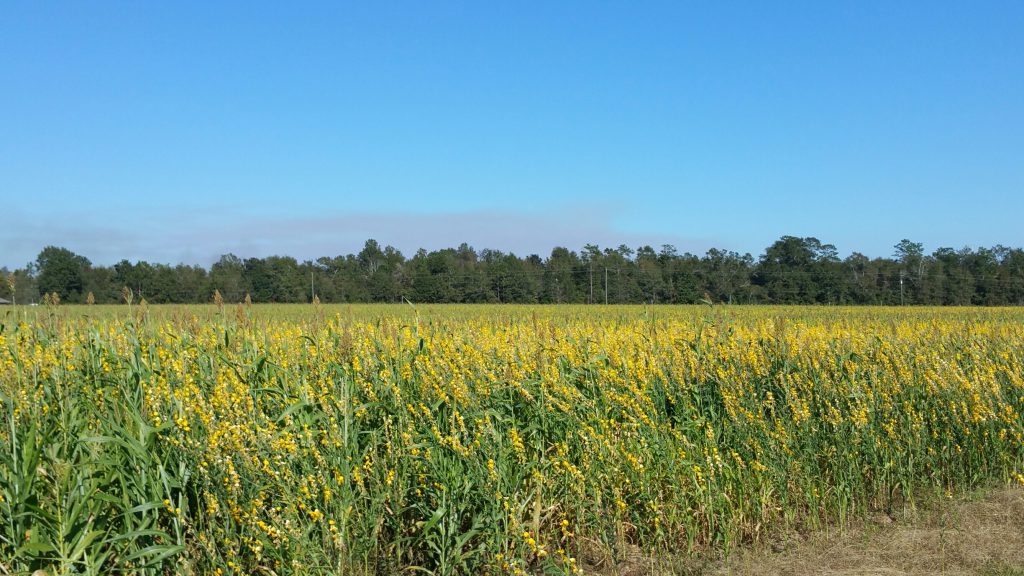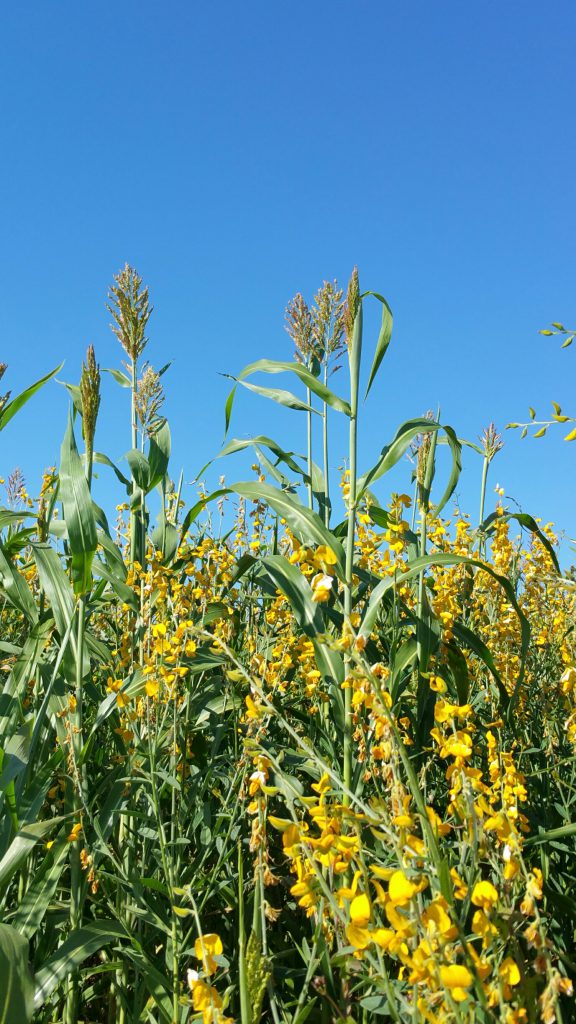
Mixture of sunn hemp and monster forage sorghum as a cover crop in Escambia County. Photo: Libbie Johnson

Mixture of sunn hemp and monster forage sorghum as a cover crop in Escambia County. Photo: Libbie Johnson
As dry as this Fall has been, planting cover crops has not been a priority or an option for many producers in the Florida Panhandle. One Escambia County grower planted an interesting cover crop mixture that has garnered a lot of attention locally this summer. Following his corn crop, he planted a mixture of sunn hemp and monster forage sorghum. Sunn hemp is a good option for those that plant corn or a fruit crop like watermelon or cantaloupe because it germinates and grows very quickly during the heat of late summer. This leguminous plant can grow to over 6 ft tall, providing a quantity of organic matter and nitrogen for our soils. The UF/IFAS Sunn hemp publication states that “Via atmospheric nitrogen fixation, sunn hemp may accumulate more than 200 pounds of nitrogen per acre. This crop also adds 2.5 to 4 tons of organic matter when incorporated into the soil.” Sunn hemp has also been touted for its ability to draw down nematode populations. Who wouldn’t benefit from growing this cover crop?
The Escambia County farmer likes to plant mixes. This year, he added Monster Forage Sorghum with the sunn hemp. In some parts of the country, forage sorghum is grown for silage instead of corn. Penn State’s publication, “Forage Sorghum” states “forage sorghum is closely related to grain sorghum, broomcorn, sorghum-sudangrass, and sudangrass. Forage sorghum is best adapted to warm regions and is particularly noted for its drought tolerance compared to corn.” There could’ve been no better year to plant this crop. When it was coming up, it looked like volunteer corn, but it kept growing and has put on seedheads despite this Fall drought. The publication goes on to say that this fast growing crop shades out weeds and has few pests. Co-planting the forage sorghum with the sunn hemp is an ideal mixture, and the drought hasn’t seemed to slow down the growth. You can’t tell by the photos, but the sunn hemp is at least 5 foot tall, and the forage sorghum is more than 6 foot tall.
Why should you consider planting cover crops?
According to the UF/IFAS publication Cover Crops, there are at least eight reasons:
- To control weeds since cover crops compete for light, water and nutrients
- To prevent soil losses associated with heavy rainfall (soil water erosion)
- To reduce soil losses due to strong winds (e.g. prevent soil wind erosion and a potential “dust bowl”) and to protect more sensitive crops such as watermelon from sand blasting damage
- To scavenge and retain nutrients that otherwise might be lost in water runoff or by leaching during the off-season. This helps reduce fertilizer costs for future crops and also protects the environment from problems caused by excess nutrient loading in our water sheds
- To reduce populations of certain soil pathogenic nematodes
- To generate supplemental income (e.g. via hay production)
- To form a suitable mulch cover for row middles and/or mulched beds
- To provide habitat for beneficial birds and insects.
Fall 2016 has been a bust for those who wanted to planted cover crops, but growers shouldn’t limit themselves to just winter plantings. There are options year round. Review the table below and think about what you might work best as a cover crop mixture for your fields in 2017.
| Crop | Yield – Biomass1 (lbs/acre) | Yield – N1
(lbs/acre) |
Seeding Rate(lbs/acre) | Seeding Date |
| ANNUAL SUMMER COVER CROPS | ||||
| Leguminous Crops | ||||
| Aeschynomene | 2000 – 4000 | 50-100 | 6-82 | Mar. 1 – June 30 |
| Alyce clover | 1500-3500 | 20-65 | 15-20 | Mid April to late June |
| Cowpeas | 4000 – 6000 | 50-90 | 6-82 | April to August |
| Hairy Indigo | 7 to 10 tons of
greenchop/acre |
80-150 | 6 – 10 | Middle of March to
May/June |
| Sesbania | 2000-8000 | 35-80 | 25-30 | Mar. 1 – July 15 |
| Sunhemp | 4500-10,000 | 90-180 | 30 – 50 | Mar. 1 – June 30 |
| Velvetbeans | 2200 – 4000 | 50-85 | 30-50 | Mar. 1 – June 30 |
| Grain Crops | ||||
| Pearlmillet | 6000-8000 | 55-70 | 12 to 15 lb/acre in rows,
of 30 to 40 lbs/acre if broadcast |
Mid March to June
in North Florida, earliest planting is April 1st. |
| Sorghum-sudan | 6500-9500 | 55-80 | 24-30 | Mar. 1 – June 30 |
| ANNUAL WINTER COVER CROPS | ||||
| Leguminous Cropos | ||||
| Crimson Clover | 1500-5000 | 35-120 | 20-25 | Oct. 1 – Nov. 15 |
| Hairy Vetch | 2000-4000 | 35-150 | 20-30 | Oct. 1 – Nov. 15 |
| Lupine | 2000-4500 | 45-120 | 30-45 | Oct. 1 – Nov. 15 |
| Grain crops | ||||
| Black oats | 1500-3500 | 20-40 | 80-100 | Oct. 1 – Nov. 15 |
| Winter rye | 3000-6000 | 30-50 | 80-100 | Oct. 15 – Nov. 15 |
| PERENNIAL COVER CROPS | ||||
| Leguminous Crops | ||||
| Rhizoma Peanut (living mulch) | 2000-10000
(12-months) |
50-130 | 80-100bu of rhizomes/acre3
(1 bu=1.25 cubic ft.) |
Dec. to March |
| Perennial Grasses | ||||
| Bahiagrass | 3000-8000 | 55-140 | 15-20 | Junt to August
(if rainfed) |
| Pangola digitgrass | 4000-9000 | 60-135 | 500-10003 | Mar. 1 – Aug. 15 |
| 1Lower productivity reflects poor growing conditions (water stress, poor inherent soil poor inherent soil fertility/inoculation) while higher values are indicative of crop performance under optimal conditions.
2Dehulled seed (naked). 3Planted vegetatively. |
||||
